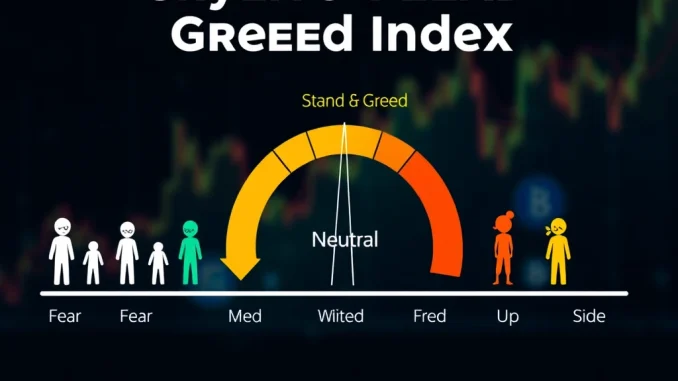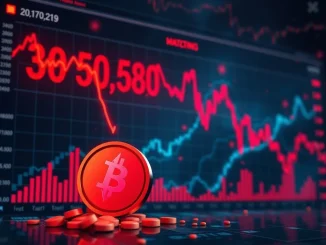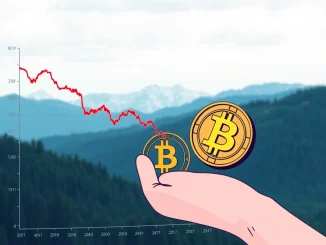
Are you watching the pulse of the market? The Crypto Fear & Greed Index is often the go-to gauge for understanding the prevailing mood among cryptocurrency investors. It’s just seen a significant shift, moving out of ‘Fear’ and into the ‘Neutral’ zone. This change in crypto market sentiment is worth paying attention to.
Understanding the Crypto Fear & Greed Index
Provided by software platform Alternative, the Crypto Fear & Greed Index is a valuable tool designed to quantify market emotions. It operates on a scale from 0 to 100:
- 0-24: Extreme Fear (Could indicate a buying opportunity for brave investors)
- 25-49: Fear (Suggests investors are worried)
- 50-54: Neutral (Represents balanced sentiment, neither overly bullish nor bearish)
- 55-74: Greed (Indicates the market is heating up)
- 75-100: Extreme Greed (Often a sign that a correction might be due)
What Factors Influence the Index?
The index isn’t based on just one metric. It aggregates data from six different sources to provide a comprehensive view:
- Volatility (25%): Measures how much the price fluctuates compared to average. Higher volatility can indicate fear or excitement.
- Market Momentum/Volume (25%): Compares current volume and market momentum to past averages. High buying volume in a rising market suggests greed.
- Social Media (15%): Analyzes sentiment and activity related to crypto on platforms like Twitter. High engagement and positive sentiment contribute to a higher score.
- Surveys (15%): Polls are conducted (though currently paused) to gauge investor sentiment directly.
- Bitcoin Dominance (10%): Looks at Bitcoin’s share of the total cryptocurrency market cap. Increasing Bitcoin dominance can sometimes signal fear as investors move towards the perceived ‘safer’ asset, or it can reflect strong positive sentiment specifically for Bitcoin.
- Google Trends (10%): Analyzes search queries related to Bitcoin and other cryptocurrencies. Rising search interest, especially for terms like ‘Bitcoin price manipulation,’ can indicate fear, while general interest suggests curiosity or greed. This is where analyzing Google Trends data becomes key.
The Recent Shift: From Fear to Neutral
As of June 7, the index registered 52, a notable jump of seven points from the previous day. This move pushed it firmly into the ‘Neutral’ territory. Previously, the market was sitting in the ‘Fear’ zone, suggesting caution among investors. The shift to 52 indicates a stabilization or slight improvement in crypto market sentiment.
What Does ‘Neutral’ Sentiment Mean?
Entering the ‘Neutral’ zone (50-54) suggests that the market is currently balanced. Investors are neither excessively fearful nor overly greedy. This phase can sometimes precede a larger move in either direction, or it can simply reflect a period of consolidation or uncertainty. It’s a point where various market forces are potentially canceling each other out.
Actionable Insights for Investors
How should investors interpret this neutral reading? It’s not a direct buy or sell signal, but rather a snapshot of the collective market mood. A neutral index suggests:
- Less Panic: The intense selling pressure often associated with ‘Extreme Fear’ or ‘Fear’ zones may be subsiding.
- Lack of Euphoria: The speculative frenzy seen during ‘Greed’ or ‘Extreme Greed’ is not currently present.
- Potential for Consolidation: The market might trade sideways as it awaits a stronger catalyst.
- Opportunity for Re-evaluation: Neutrality allows investors to assess their positions without the emotional extremes driving decisions. Consider factors like volatility and recent price action alongside the index.
Conclusion: Watching the Mood Meter
The rise of the Crypto Fear & Greed Index to 52 and its entry into the ‘Neutral’ zone marks a meaningful change from the recent ‘Fear’ period. While not predicting future price movements, this shift in crypto market sentiment provides valuable context. By monitoring the index and its underlying factors, including Bitcoin dominance and insights from Google Trends, investors can gain a better understanding of the emotional state driving the market, helping them make more informed decisions away from emotional extremes.



